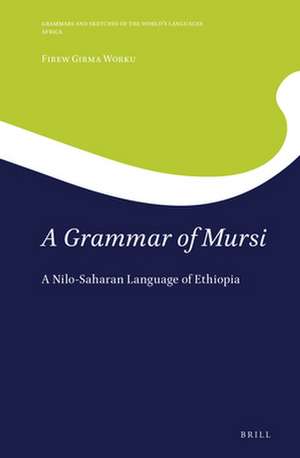A Grammar of Mursi: A Nilo-Saharan Language of Ethiopia: Grammars and Sketches of the World's Languages / Africa, cartea 15
Autor Firew Girma Workuen Limba Engleză Hardback – 10 mar 2021
Based on the fieldwork that the author conducted in beautiful villages of the Mursi community, this descriptive grammar is organized into fourteen chapters rich in examples and an appendix containing four transcribed texts. The readers are thus provided with a clear and useful tool, which constitutes and important addition to our knowledge of Mursi and of other related languages spoken in the area.
Besides being an empirical data source for linguists interested in typology and endangered language description and documentation, the grammar constitutes an invaluable gift to the speech community.
Preț: 1060.31 lei
Preț vechi: 1293.06 lei
-18% Nou
Puncte Express: 1590
Preț estimativ în valută:
202.92€ • 211.06$ • 167.52£
202.92€ • 211.06$ • 167.52£
Carte indisponibilă temporar
Doresc să fiu notificat când acest titlu va fi disponibil:
Se trimite...
Preluare comenzi: 021 569.72.76
Specificații
ISBN-13: 9789004449893
ISBN-10: 9004449892
Dimensiuni: 155 x 235 mm
Greutate: 0 kg
Editura: Brill
Colecția Brill
Seria Grammars and Sketches of the World's Languages / Africa
ISBN-10: 9004449892
Dimensiuni: 155 x 235 mm
Greutate: 0 kg
Editura: Brill
Colecția Brill
Seria Grammars and Sketches of the World's Languages / Africa
Cuprins
Acknowledgements
List of Tables, Maps, Diagrams, and Figures
Abbreviations and Conventions
1 Introduction
1.1The Mursi People: Historical Background
1.2Linguistic Profile of Mursi
1.3Geography and Mursi Neighbours
1.4Economy and Subsistence
1.5Traditional Leadership
1.6Local Groups, Clans, Kinship System and Age Sets
1.7Major Traditional Practices
1.8Cattle, Color Terms and Naming
1.9Linguistic Affiliation
1.10Sociolinguistic Situation
1.11Previous Studies; Ethnographic Exploration in the Lower Omo Valley
1.12Fieldwork Methodology and Language Data
2 Phonology
2.1Introduction
2.2Notes on Orthography and Phonetic Transcriptions
2.3Inventory of Phonemes
2.4Syllable Structure
2.5Phonological Processes
2.6Tone
2.7Wordhood
2.8Clitics
2.9Special Phonology
2.10Female Register
3 Word Classes
3.1Introduction
3.2Open Word Classes
3.3Closed Word Classes
4 Noun Phrase Structure
4.1Introduction
4.2Non-clausal Modifiers of NP
4.3Clausal Modifiers
4.4Nominalizers
4.5Complex Modification
4.6Summary of Head-Modifier Dependency Relation
5 Possession
5.1Introduction
5.2Juxtaposed System
5.3Possessive Construction with A and B Possessors
5.4Possessive Construction with C-type (Possessive Pronouns)
5.5Pertensive
5.6Noun Modification Constructions
5.7Predicative Possessive Construction
5.8Summary
6 Number
6.1Introduction
6.2The Realization of Number
6.3Suffixation
6.4Suppletion
6.5Number Marking by Tone
6.6n/g Alternation
6.7The Bound Number/Aspect Marking Forms -t/-ɗ
6.8Additional Suffixes
6.9Number-Determined Suppletive Verb Forms
6.10Reduplication
6.11Number Words
6.12Number and Agreement
7 The Verb and Predicate Structure
7.1Introduction
7.2Phonological Properties of Verb Roots
7.3Morphological Properties
8 Adjectives
8.1Introduction
8.2Phonological Properties of Adjectives
8.3Morphological Properties of Adjectives
8.4Syntactic Properties
8.5Semantic Properties
8.6Summary
9 Valency Changing Operations
9.1Introduction
9.2Valency Decreasing Derivations
9.3Valency-Increasing Derivations
10 Grammatical Relations
10.1Introduction
10.2Constituent Order
10.3Case Markers
10.4Adpositions
10.5Verb-Final Suffix
11 Comparative Constructions
11.1Introduction
11.2Mono-clausal Comparative Construction
11.3Phrasal plus Mono-clausal Construction
11.4Bi-clausal Construction Type I
11.5Bi-clausal Construction Type II
11.6ɓá Construction
11.7Other Types of Comparative Constructions
11.8Equality Construction
12 Questions
12.1Introduction
12.2Content Questions
12.3Non-interrogative Particles
12.4Tag Questions
12.5Polar Questions
12.6Other Question Strategies
13 Negation
13.1Introduction
13.2Bound Negators
13.3Negating a Copula Clause
13.4Negative Existential Verb níŋɛ ‘Not Present’
13.5Inherently Negative Verb ímág
13.6Indefinite-Like Words
13.7Interjection ɪmm ɪmm ‘no’
13.8Tracing and Linking Negators
14 Clause Types, Clause Combining and Coordination
14.1Introduction
14.2Clause Types
14.3Clause Coordination
Appendix: Transcribed Texts
Bibliography
Subject Index
List of Tables, Maps, Diagrams, and Figures
Abbreviations and Conventions
1 Introduction
1.1The Mursi People: Historical Background
1.2Linguistic Profile of Mursi
1.3Geography and Mursi Neighbours
1.4Economy and Subsistence
1.5Traditional Leadership
1.6Local Groups, Clans, Kinship System and Age Sets
1.7Major Traditional Practices
1.8Cattle, Color Terms and Naming
1.9Linguistic Affiliation
1.10Sociolinguistic Situation
1.11Previous Studies; Ethnographic Exploration in the Lower Omo Valley
1.12Fieldwork Methodology and Language Data
2 Phonology
2.1Introduction
2.2Notes on Orthography and Phonetic Transcriptions
2.3Inventory of Phonemes
2.4Syllable Structure
2.5Phonological Processes
2.6Tone
2.7Wordhood
2.8Clitics
2.9Special Phonology
2.10Female Register
3 Word Classes
3.1Introduction
3.2Open Word Classes
3.3Closed Word Classes
4 Noun Phrase Structure
4.1Introduction
4.2Non-clausal Modifiers of NP
4.3Clausal Modifiers
4.4Nominalizers
4.5Complex Modification
4.6Summary of Head-Modifier Dependency Relation
5 Possession
5.1Introduction
5.2Juxtaposed System
5.3Possessive Construction with A and B Possessors
5.4Possessive Construction with C-type (Possessive Pronouns)
5.5Pertensive
5.6Noun Modification Constructions
5.7Predicative Possessive Construction
5.8Summary
6 Number
6.1Introduction
6.2The Realization of Number
6.3Suffixation
6.4Suppletion
6.5Number Marking by Tone
6.6n/g Alternation
6.7The Bound Number/Aspect Marking Forms -t/-ɗ
6.8Additional Suffixes
6.9Number-Determined Suppletive Verb Forms
6.10Reduplication
6.11Number Words
6.12Number and Agreement
7 The Verb and Predicate Structure
7.1Introduction
7.2Phonological Properties of Verb Roots
7.3Morphological Properties
8 Adjectives
8.1Introduction
8.2Phonological Properties of Adjectives
8.3Morphological Properties of Adjectives
8.4Syntactic Properties
8.5Semantic Properties
8.6Summary
9 Valency Changing Operations
9.1Introduction
9.2Valency Decreasing Derivations
9.3Valency-Increasing Derivations
10 Grammatical Relations
10.1Introduction
10.2Constituent Order
10.3Case Markers
10.4Adpositions
10.5Verb-Final Suffix
11 Comparative Constructions
11.1Introduction
11.2Mono-clausal Comparative Construction
11.3Phrasal plus Mono-clausal Construction
11.4Bi-clausal Construction Type I
11.5Bi-clausal Construction Type II
11.6ɓá Construction
11.7Other Types of Comparative Constructions
11.8Equality Construction
12 Questions
12.1Introduction
12.2Content Questions
12.3Non-interrogative Particles
12.4Tag Questions
12.5Polar Questions
12.6Other Question Strategies
13 Negation
13.1Introduction
13.2Bound Negators
13.3Negating a Copula Clause
13.4Negative Existential Verb níŋɛ ‘Not Present’
13.5Inherently Negative Verb ímág
13.6Indefinite-Like Words
13.7Interjection ɪmm ɪmm ‘no’
13.8Tracing and Linking Negators
14 Clause Types, Clause Combining and Coordination
14.1Introduction
14.2Clause Types
14.3Clause Coordination
Appendix: Transcribed Texts
Bibliography
Subject Index
Notă biografică
Firew Girma Worku, Ph.D. (2020), James Cook University, is an Adjunct Research Fellow of the College of Arts, Society and Education at that university. He specializes in Nilo-Saharan languages particularly in Surmic languages. His main interests consist describing and documenting endangered languages, linguistic anthropology, and typology.






